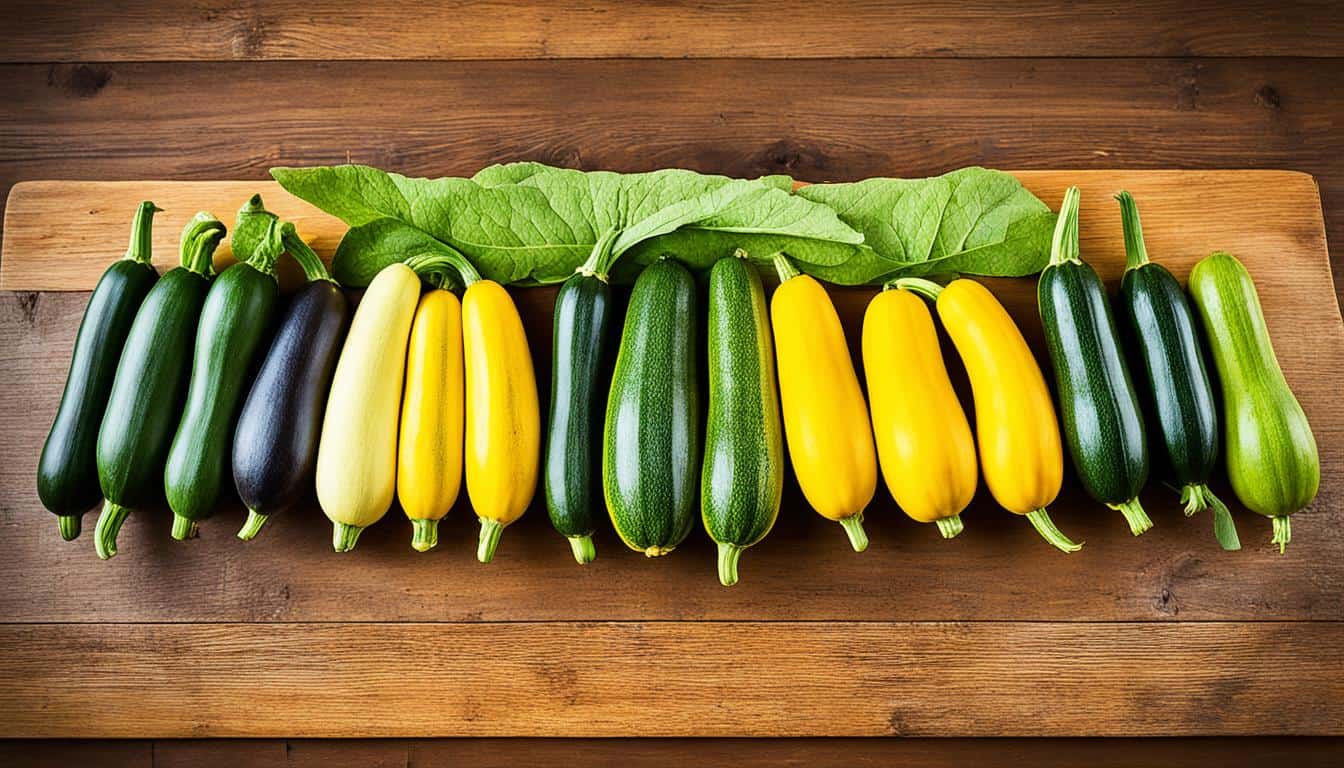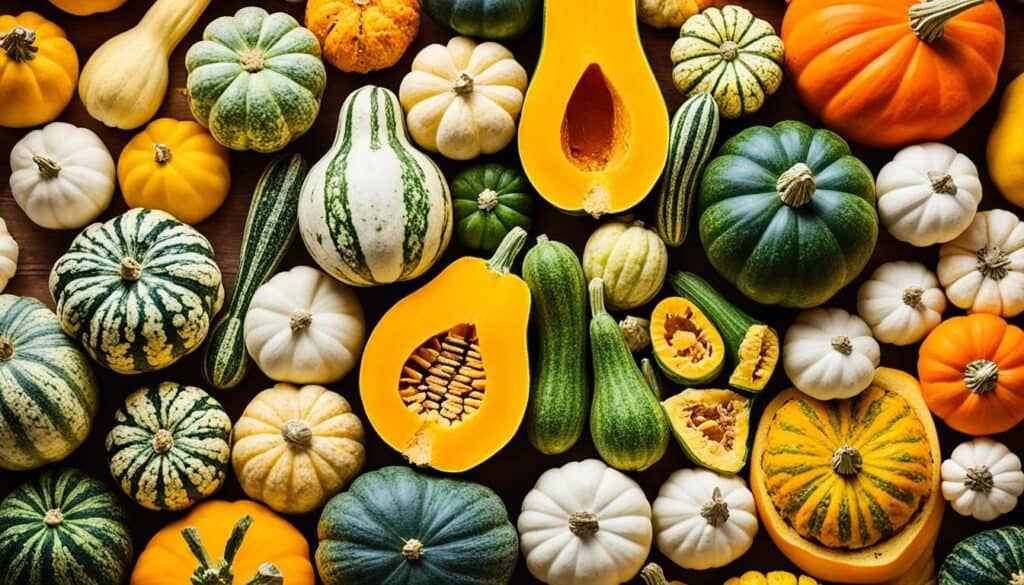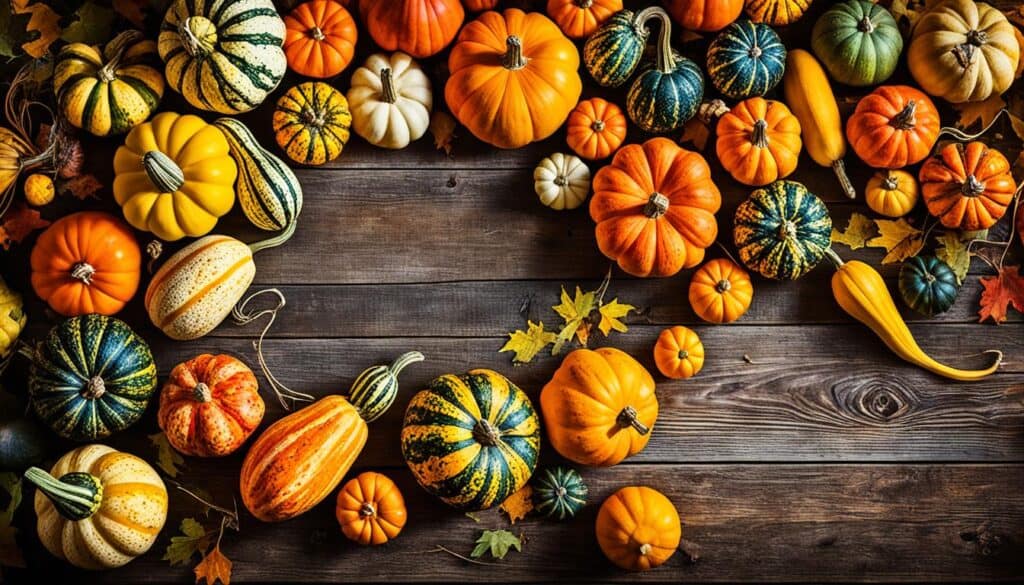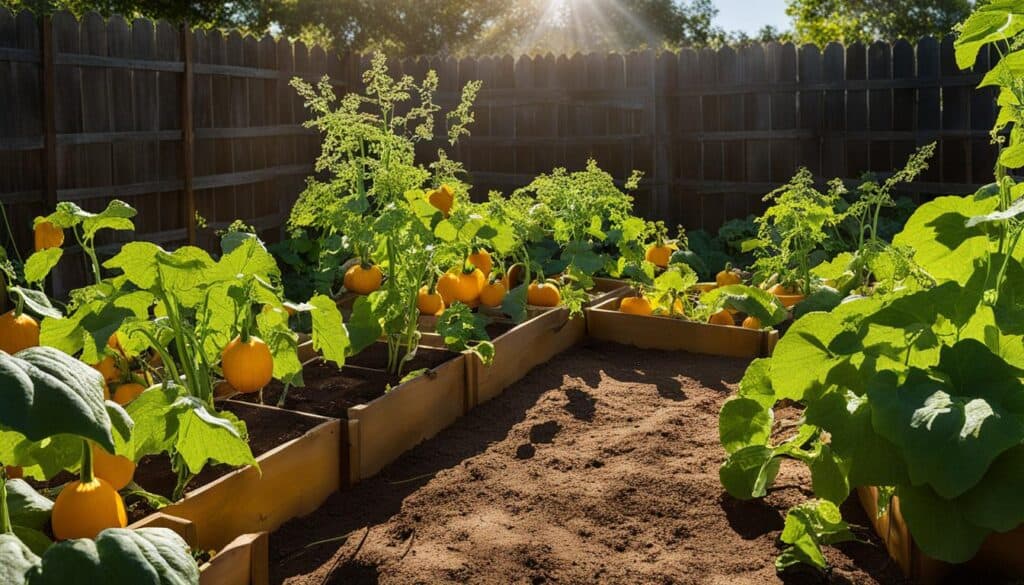Did you know that there are over 100 different types of squash grown worldwide? From the familiar favorites to the lesser-known varieties, the world of squash is diverse and enticing. Whether you’re a seasoned gardener or simply a lover of flavorful vegetables, exploring the vast array of squash options is both exciting and delicious.
In this article, I’ll take you on a journey to discover the varied types of squash, from the vibrant hues of yellow and green to the rich and hearty winter squash. We’ll explore their unique characteristics, culinary uses, and even give you some tips on growing your own squash at home.
So, whether you’re looking to expand your culinary repertoire or seek inspiration for your garden, join me as we delve into the wonderful world of squash varieties.
Key Takeaways:
- There are over 100 different types of squash varieties available.
- Squash comes in various colors, flavors, and textures.
- Winter squash has thick skins and sweet flesh, while summer squash has tender skins and milder flavors.
- Squash can be cooked in numerous ways, including sautéing, roasting, grilling, and pureeing.
- Growing squash at home is a rewarding experience that allows you to enjoy fresh, flavorful produce.
Types of Winter Squash
Winter squash varieties are known for their hard, thick skins, sweet flesh, and mature seeds. They are a perfect addition to hearty and comforting winter dishes. Let’s take a look at some popular types of winter squash:
- Acorn Squash
- Banana Squash
- Buttercup Squash
- Butternut Squash
- Carnival Squash
- Delicata Squash
- Kabocha Squash
- Hubbard Squash
- Honeynut Squash
- Pumpkin
- Red Kuri Squash
- Spaghetti Squash
- Sweet Dumpling Squash
- Turban Squash
Each variety has its own unique flavor and texture, making them suitable for various cooking methods. From the rich and nutty taste of butternut squash to the slightly sweet and creamy texture of delicata squash, there’s a winter squash variety to suit every palate.
Winter squash varieties can be roasted, baked, mashed, or used in soups and stews. They can also be used as a flavorful ingredient in pies, muffins, and bread. The versatility of winter squash makes it a favorite ingredient during the colder months.
Types of Summer Squash
Summer squash varieties are characterized by their tender skins, edible flowers, and milder flavors. These versatile vegetables are a staple during the summer months when they are at their peak freshness and flavor. Let’s take a closer look at some of the different types of summer squash:
Cousa Squash
Cousa squash, also known as Lebanese squash, is a smaller variety of squash with pale green skin and a sweet, nutty flavor. It has a creamy texture and is often used in Mediterranean and Middle Eastern cuisines.
Chayote (Mirliton)
Chayote, also called mirliton, is a pear-shaped squash with a smooth, pale green skin. It has a crisp texture and a mild, slightly sweet flavor. Chayote is commonly used in soups, salads, stir-fries, and as a substitute for potatoes in some dishes.
Crookneck Squash
Crookneck squash is easily recognized by its bent neck and vibrant yellow skin. It has a buttery flavor and tender flesh. This summer squash is delicious when sautéed, grilled, or added to casseroles.
Patty Pan Squash
Patty pan squash, also known as scallop squash, is named for its unique scalloped edges and flat, round shape. It comes in various colors, including white, yellow, and green. This squash has a delicate, buttery flavor and a firm texture. It can be roasted, baked, steamed, or used in stuffing.
Round Zucchini
Round zucchini, as the name suggests, is a spherical variety of squash. It has a tender, mild flavor and can be used in various dishes, including sautés, stews, and stuffed vegetables.
Squash Blossoms
Squash blossoms are the edible flowers that grow on squash plants. They have a delicate, slightly sweet flavor and a vibrant appearance. These blossoms are often stuffed with cheese or used as a topping for salads, pizzas, and other dishes.
Yellow Squash
Yellow squash is a popular variety that is easily recognizable by its bright yellow skin. It has a mild, slightly sweet flavor and a firm texture. Yellow squash is delicious when grilled, sautéed, or used in various dishes, including casseroles and stir-fries.
Zephyr Squash
Zephyr squash is a hybrid variety that combines the characteristics of yellow and green squash. It has a light yellow color with green stripes and a delicate, sweet flavor. Zephyr squash can be used in a variety of ways, including grilling, roasting, and sautéing.
Zucchini
Zucchini is a popular summer squash with a versatile flavor and texture. It has a mild, slightly sweet taste and a tender flesh. Zucchini can be enjoyed raw in salads, grilled, roasted, baked, or used as a substitute for pasta in dishes like zoodles.
These are just a few examples of the different types of summer squash available. Each variety offers its own unique characteristics and can be used in a variety of culinary creations. Whether you’re looking to add some color to your salads, create a flavorful side dish, or experiment with new recipes, summer squash varieties are a delicious choice.
Selecting and Storing Squash
When it comes to selecting the perfect squash, there are a few key factors to consider. Look for squash that is firm, heavy for its size, and free from blemishes or bruises. The skin should have a matte appearance and should not be shiny. These indicators ensure that the squash is fresh and of high quality.
Winter squash varieties, such as acorn squash, butternut squash, and pumpkin, have a longer shelf life compared to summer squash like zucchini and yellow squash. To store winter squash, keep them in a cool, dry area with good ventilation. This can be your pantry or a shelf in the garage. The ideal temperature range for storing winter squash is between 50°F and 60°F (10°C and 15°C). Make sure to check the squash regularly and discard any damaged or rotting ones to prevent spoilage.
Once you’ve peeled or cut winter squash, it’s important to use it within a few days to maintain its freshness and prevent waste.
On the other hand, summer squash varieties have a shorter shelf life and should be refrigerated to maintain their freshness. Store them in a plastic bag or airtight container in the refrigerator. Summer squash should be consumed within a week to ensure the best taste and texture.
Properly selecting and storing squash is essential to ensure their longevity and to enjoy their delicious flavors in your favorite recipes.
Tips for Selecting Squash:
- Choose squash that is firm, heavy, and free from blemishes or bruises.
- Look for a matte skin that is not shiny.
Tips for Storing Squash:
Winter squash:
- Keep in a cool, dry area with good ventilation.
- Temperature range: 50°F to 60°F (10°C to 15°C).
- Regularly check for damage or rot.
- Use within a few days once peeled or cut.
Summer squash:
- Refrigerate in a plastic bag or airtight container.
- Consume within a week for best freshness.
By following these tips, you can ensure that your squash stays fresh and delicious for as long as possible.
Ways to Cook Squash
Squash is a versatile vegetable that can be cooked in various ways, allowing you to explore different flavors and textures. Whether you prefer a savory side dish or a sweet treat, there are numerous methods to prepare squash that will satisfy your taste buds.
One popular cooking method for squash is sautéing. Simply slice or dice the squash and cook it in a skillet with a bit of oil or butter. This method gives the squash a tender texture and allows it to absorb the flavors of any seasonings or spices you add. Sautéed squash can be enjoyed as a standalone side dish or incorporated into recipes like stir-fries and pasta dishes.
If you prefer a roasted flavor, roasting squash is a delicious option. Cut the squash into chunks or wedges, place them on a baking sheet, drizzle with olive oil, and season with your choice of herbs and spices. Roast the squash in the oven until it becomes tender and caramelized. Roasted squash can be served as a hearty side dish or as an ingredient in salads, grain bowls, and sandwiches.
If you want to enhance the natural flavors of squash, consider grilling it. Slice the squash lengthwise or into thick rounds, brush it with oil or marinade, and grill it over medium heat until it becomes lightly charred and tender. Grilled squash adds a smoky flavor to your dishes and pairs well with grilled meats, burgers, or served as a standalone grilled veggie dish.
Squash is also a great candidate for pureeing due to its soft texture when cooked. After cooking the squash until it becomes tender, transfer it to a blender or food processor and blend until smooth. You can use the pureed squash as a base for soups, sauces, or even incorporate it into baked goods like muffins and bread. The puree adds a creamy and slightly sweet element to your recipes.
Spiralizing Summer Squash into Zoodles
For a fun twist on traditional pasta, you can spiralize summer squash into “zoodles.” Using a spiralizer, create thin noodle-like strands from the summer squash. The zoodles can be enjoyed raw in salads or lightly sautéed for a cooked dish. They serve as a healthy and low-carb substitute for traditional pasta, allowing you to indulge in a satisfying meal without the heaviness of wheat-based noodles.
Here’s a table summarizing the cooking methods for squash:
| Cooking Method | Description |
|---|---|
| Sautéing | Cooking squash in a skillet with oil or butter, resulting in a tender texture and flavorful dish. |
| Roasting | Baking squash in the oven until it becomes tender, caramelized, and rich in flavor. |
| Grilling | Cooking squash on a grill to enhance its natural flavors and add a smoky taste. |
| Pureeing | Blending cooked squash into a smooth puree, perfect for soups, sauces, and baked goods. |
| Spiralizing | Transforming summer squash into noodle-like strands, offering a low-carb alternative to pasta. |
As you can see, there are numerous ways to incorporate squash into your culinary repertoire. Whether you’re a fan of classic recipes or enjoy experimenting with new flavors, cooking squash provides endless possibilities for delicious and satisfying meals.
Health Benefits of Squash
Squash is a nutritious vegetable that offers several health benefits. It is a good source of fiber, vitamins A and C, and antioxidants. Winter squash varieties like acorn squash and butternut squash are especially high in fiber. Squash also has anti-inflammatory properties and can contribute to a healthy diet. It is a low-carb vegetable, making it suitable for those following a low-carbohydrate eating plan.
| Health Benefits | Nutritional Value |
|---|---|
| Squash is rich in fiber, which promotes healthy digestion and helps prevent constipation. | High in fiber |
| Squash is an excellent source of vitamins A and C, which support a strong immune system. | Rich in vitamins A and C |
| The antioxidants found in squash help protect the body against free radicals and oxidative stress. | Contains antioxidants |
| Squash has anti-inflammatory properties, which may help reduce inflammation in the body. | Anti-inflammatory |
| Being low in carbohydrates, squash is a suitable option for those following a low-carbohydrate eating plan. | Low-carb vegetable |
Incorporating squash into your diet can provide you with essential nutrients and contribute to a healthy lifestyle. Whether roasted, sautéed, or used in a variety of dishes, squash is a versatile and flavorful addition to any meal.
Squash as a Fruit or Vegetable
The classification of squash as a fruit or vegetable can be a topic of debate. Technically, squash is a fruit because it contains seeds and flowers. However, due to its culinary uses and the way it is typically prepared and consumed, squash is often referred to as a vegetable. The distinction between fruits and vegetables can be ambiguous, but from a botanical standpoint, squash is considered a fruit.
When it comes to the classification of squash, it’s important to consider both its botanical definition and its culinary context. From a botanical perspective, squash meets the criteria for a fruit because it develops from the flower and contains seeds. Fruits are the mature ovaries of flowering plants, a definition that squash aligns with.
However, in common usage and in the culinary world, squash is often regarded as a vegetable. This is because squash is typically savory and used in dishes alongside other vegetables. It is prepared and consumed in ways that are more commonly associated with vegetables, such as roasting, sautéing, and grilling.
“Although squash is technically a fruit, it is commonly referred to as a vegetable due to its culinary uses and the way it is typically prepared and consumed.”
The ambiguity of whether squash is a fruit or vegetable extends beyond squash itself. Many other fruits, such as tomatoes, cucumbers, and bell peppers, are often considered vegetables in cooking and culinary contexts. The classification of fruits versus vegetables can vary depending on cultural and culinary traditions.
In conclusion, while squash is botanically classified as a fruit, it is commonly referred to as a vegetable in culinary contexts. Whether you classify it as a fruit or a vegetable, one thing is certain – squash is a versatile ingredient with a wide range of culinary applications and nutritional benefits.
The Relationship Between Squash, Pumpkins, and Gourds
Squash, pumpkins, and gourds are closely related members of the Cucurbitaceae plant family. While pumpkins can be classified as a type of squash, gourds have distinct differences and are primarily used for decorative purposes.
Pumpkins and Squash:
Pumpkins and squash share similar characteristics and flavors, making them often confused or used interchangeably in culinary dishes. They both belong to the Cucurbita genus and come in a variety of shapes, sizes, and colors.
Gourds:
Gourds, on the other hand, are not edible and have a more fibrous and hard texture compared to squash and pumpkins. They are typically used in crafts and for ornamental purposes, such as making birdhouses, musical instruments, and decorations.
The Relationship:
The relationship between squash, pumpkins, and gourds lies in their botanical classification within the Cucurbitaceae plant family. The distinct characteristics of each member make them unique, yet they share common ancestry and traits.
The Cucurbitaceae Plant Family
“The Cucurbitaceae family includes various plants that bear fruits with hard and moisture-rich outer shells.”
– Botanist Lisa Green
Interpreting the relationship between squash, pumpkins, and gourds can be as fascinating as exploring their diverse range of shapes, colors, and flavors. Let’s dive deeper into each member of this plant family and uncover the intricate details that make them so unique.
Growing Squash
As an avid gardener, I find growing squash to be a rewarding and enjoyable experience. Whether you have a large backyard or a small patio, squash can be easily grown in home gardens. With a little knowledge and care, you can produce your own delicious harvest of fresh squash. Here are some tips for successfully growing squash in your garden:
1. Choose the Right Variety
When selecting squash seeds or transplants, consider the different varieties available. There are numerous types of squash, including butternut, zucchini, acorn, and spaghetti squash. Each variety has its own unique flavor and growth habits. Make sure to choose a variety that is suited to your growing conditions and culinary preferences.
2. Provide Ample Sunlight
Squash plants thrive in warm, sunny locations. Find a spot in your garden that receives at least 6-8 hours of direct sunlight each day. This will ensure that your squash plants grow strong and healthy, producing abundant fruit.
3. Prepare Well-Drained Soil
Squash plants prefer well-drained soil that is rich in organic matter. Before planting, enhance the soil by adding compost or well-rotted manure. This will provide essential nutrients and improve the soil structure, allowing the roots to grow and absorb water more efficiently.
4. Water Regularly
Squash plants require regular watering, especially during dry spells. Water deeply, ensuring that the soil is moist but not saturated. Avoid overwatering, as this can lead to root rot and other moisture-related issues. Mulching around the plants can help retain soil moisture and suppress weeds.
5. Control Pests and Diseases
Just like any other garden plant, squash is susceptible to pests and diseases. Keep an eye out for common pests such as squash bugs and cucumber beetles. Implement organic pest control methods, such as handpicking or using insecticidal soap, to protect your plants. It’s also important to monitor for diseases like powdery mildew and take necessary measures, such as applying fungicides or practicing crop rotation, to prevent their spread.
6. Harvest at the Right Time
Knowing when to harvest your squash is crucial for optimum flavor and texture. Different varieties have different maturity indicators, such as color or size. Generally, squash is ready for harvest when it reaches a mature size, has a firm skin, and is fully colored. Use a sharp knife or pruning shears to cut the squash from the vine, leaving a short stem attached.
By following these tips, you can cultivate a successful squash garden and enjoy the bountiful rewards of your labor. Growing squash not only provides you with fresh and nutritious produce but also allows you to connect with nature and experience the joy of growing your own food.
Popular Squash Varieties for Growing and Cooking
When it comes to popular squash varieties for both growing and cooking, there are several options to choose from. These versatile squash varieties offer a range of flavors, textures, and culinary uses, making them a great addition to any kitchen.
“The key to enjoying squash is finding the right variety that suits your taste and cooking preferences.” – Me
One popular variety is the butternut squash, known for its sweet and nutty flavor. It’s perfect for roasting, making soups, or even adding to pasta dishes. Zucchini is another crowd favorite, with its mild flavor and tender texture. It can be grilled, sautéed, or spiralized into zoodles for a healthy alternative to pasta.
For those looking to experiment with different flavors, the acorn squash offers a slightly sweet and nutty taste, while spaghetti squash is known for its unique stringy texture that resembles spaghetti noodles when cooked. Both varieties can be roasted, stuffed, or used in casseroles.
If you’re in the mood for some autumnal flavors, pumpkins are a popular choice. They can be used in a variety of dishes, from pies and soups to roasted seeds. Kabocha squash is another flavorful option, with its sweet and velvety flesh. It’s commonly used in Asian cuisine and can be grilled, steamed, or added to stews.
For a smaller and more delicate option, delicata squash is a popular choice. It has a thin skin that can be eaten when cooked, and its creamy texture pairs well with both savory and sweet dishes.
The possibilities are endless when it comes to cooking with these versatile squash varieties. Here are some ideas to get you started:
- Roast butternut squash with olive oil, garlic, and rosemary for a flavorful side dish.
- Sauté zucchini with onions and bell peppers for a colorful and nutritious stir-fry.
- Stuff acorn squash with a mixture of quinoa, vegetables, and feta cheese for a delicious vegetarian main course.
- Top spaghetti squash with your favorite marinara sauce and meatballs for a low-carb twist on spaghetti and meatballs.
- Bake pumpkin into a creamy pumpkin pie or make pumpkin bread for a seasonal treat.
- Steam kabocha squash and serve it with a drizzle of soy sauce and sesame seeds for a simple yet flavorful side dish.
- Roast delicata squash slices with maple syrup, cinnamon, and pecans for a sweet and savory autumn-inspired side.
With these popular squash varieties, you can get creative in the kitchen and explore a variety of flavors and cooking methods. So, whether you’re a seasoned chef or a beginner in the culinary world, don’t hesitate to incorporate these versatile squash varieties into your cooking repertoire.
Conclusion
Squash is a versatile and delicious vegetable that offers a wide range of flavors and textures. Whether you prefer the sweet and nutty taste of winter squash or the tender and mild flavors of summer squash, there is a variety that will suit your palate. From acorn squash to zucchini, the world of squash is full of exciting options to explore.
Whether you grow your own squash in your garden or purchase it from your local grocery store, incorporating different types of squash into your meals can add variety and excitement to your cooking. With so many culinary possibilities, you can roast, sauté, grill, or puree squash to create delicious and nutritious dishes.
Key takeaways from this exploration of squash varieties include the fact that winter squash has hard, thick skins and sweet flesh, while summer squash has tender skins and milder flavors. Additionally, squash is a source of fiber, vitamins A and C, and antioxidants, making it a healthy choice for any diet.
In conclusion, whether you’re a home cook, a food enthusiast, or someone simply looking to try new vegetables, the diverse world of squash offers something for everyone. So, why not embrace the wonderful flavors and culinary possibilities by incorporating squash into your next meal? Your taste buds and your health will thank you!










Leave a Reply